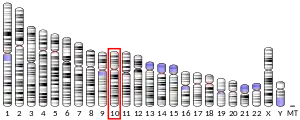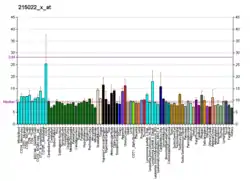| ZNF33B | |||||||||||||||||||||||||||||||||||||||||||||||||||
|---|---|---|---|---|---|---|---|---|---|---|---|---|---|---|---|---|---|---|---|---|---|---|---|---|---|---|---|---|---|---|---|---|---|---|---|---|---|---|---|---|---|---|---|---|---|---|---|---|---|---|---|
| Identifiers | |||||||||||||||||||||||||||||||||||||||||||||||||||
| Aliases | ZNF33B, KOX2, KOX31, ZNF11B, zinc finger protein 33B | ||||||||||||||||||||||||||||||||||||||||||||||||||
| External IDs | OMIM: 194522 HomoloGene: 130561 GeneCards: ZNF33B | ||||||||||||||||||||||||||||||||||||||||||||||||||
| |||||||||||||||||||||||||||||||||||||||||||||||||||
| |||||||||||||||||||||||||||||||||||||||||||||||||||
| |||||||||||||||||||||||||||||||||||||||||||||||||||
| |||||||||||||||||||||||||||||||||||||||||||||||||||
| Wikidata | |||||||||||||||||||||||||||||||||||||||||||||||||||
| |||||||||||||||||||||||||||||||||||||||||||||||||||
Zinc finger protein 33B is a protein that in humans is encoded by the ZNF33B gene.[3][4]
References
- 1 2 3 GRCh38: Ensembl release 89: ENSG00000196693 - Ensembl, May 2017
- ↑ "Human PubMed Reference:". National Center for Biotechnology Information, U.S. National Library of Medicine.
- ↑ Huebner K, Druck T, Croce CM, Thiesen HJ (May 1991). "Twenty-seven nonoverlapping zinc finger cDNAs from human T cells map to nine different chromosomes with apparent clustering". Am J Hum Genet. 48 (4): 726–40. PMC 1682948. PMID 2014798.
- ↑ "Entrez Gene: ZNF33B zinc finger protein 33B".
Further reading
- Rousseau-Merck MF, Tunnacliffe A, Berger R, et al. (1992). "A cluster of expressed zinc finger protein genes in the pericentromeric region of human chromosome 10". Genomics. 13 (3): 845–8. doi:10.1016/0888-7543(92)90166-P. PMID 1639412.
- Thiesen HJ (1991). "Multiple genes encoding zinc finger domains are expressed in human T cells". New Biol. 2 (4): 363–74. PMID 2288909.
- Tunnacliffe A, Liu L, Moore JK, et al. (1993). "Duplicated KOX zinc finger gene clusters flank the centromere of human chromosome 10: evidence for a pericentric inversion during primate evolution". Nucleic Acids Res. 21 (6): 1409–17. doi:10.1093/nar/21.6.1409. PMC 309326. PMID 8464732.
- Strausberg RL, Feingold EA, Grouse LH, et al. (2003). "Generation and initial analysis of more than 15,000 full-length human and mouse cDNA sequences". Proc. Natl. Acad. Sci. U.S.A. 99 (26): 16899–903. Bibcode:2002PNAS...9916899M. doi:10.1073/pnas.242603899. PMC 139241. PMID 12477932.
- Guy J, Hearn T, Crosier M, et al. (2003). "Genomic sequence and transcriptional profile of the boundary between pericentromeric satellites and genes on human chromosome arm 10p". Genome Res. 13 (2): 159–72. doi:10.1101/gr.644503. PMC 420363. PMID 12566394.
- Ota T, Suzuki Y, Nishikawa T, et al. (2004). "Complete sequencing and characterization of 21,243 full-length human cDNAs". Nat. Genet. 36 (1): 40–5. doi:10.1038/ng1285. PMID 14702039.
- Deloukas P, Earthrowl ME, Grafham DV, et al. (2004). "The DNA sequence and comparative analysis of human chromosome 10". Nature. 429 (6990): 375–81. Bibcode:2004Natur.429..375D. doi:10.1038/nature02462. PMID 15164054.
- Gerhard DS, Wagner L, Feingold EA, et al. (2004). "The status, quality, and expansion of the NIH full-length cDNA project: the Mammalian Gene Collection (MGC)". Genome Res. 14 (10B): 2121–7. doi:10.1101/gr.2596504. PMC 528928. PMID 15489334.
External links
- ZNF33B+protein,+human at the U.S. National Library of Medicine Medical Subject Headings (MeSH)
This article incorporates text from the United States National Library of Medicine, which is in the public domain.
This article is issued from Wikipedia. The text is licensed under Creative Commons - Attribution - Sharealike. Additional terms may apply for the media files.


